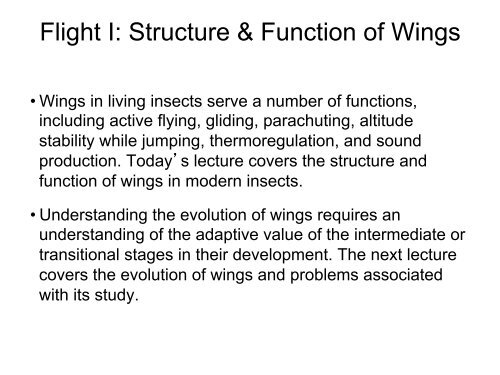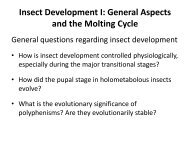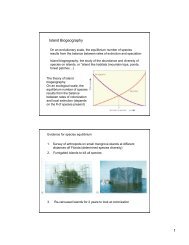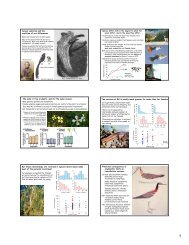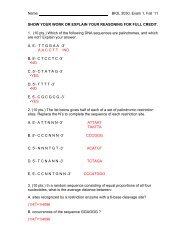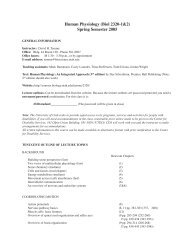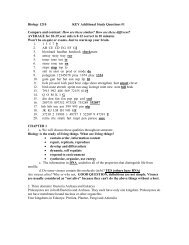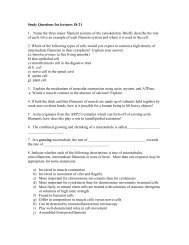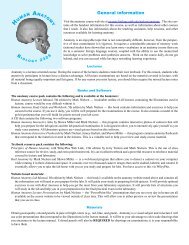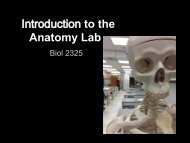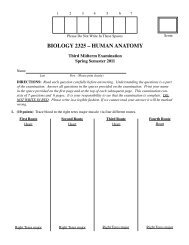Flight I: Structure & Function of Wings - Biology Courses Server
Flight I: Structure & Function of Wings - Biology Courses Server
Flight I: Structure & Function of Wings - Biology Courses Server
- No tags were found...
You also want an ePaper? Increase the reach of your titles
YUMPU automatically turns print PDFs into web optimized ePapers that Google loves.
<strong>Flight</strong> I: <strong>Structure</strong> & <strong>Function</strong> <strong>of</strong> <strong>Wings</strong>• <strong>Wings</strong> in living insects serve a number <strong>of</strong> functions,including active flying, gliding, parachuting, altitudestability while jumping, thermoregulation, and soundproduction. Today’s lecture covers the structure andfunction <strong>of</strong> wings in modern insects.• Understanding the evolution <strong>of</strong> wings requires anunderstanding <strong>of</strong> the adaptive value <strong>of</strong> the intermediate ortransitional stages in their development. The next lecturecovers the evolution <strong>of</strong> wings and problems associatedwith its study.
<strong>Structure</strong> <strong>of</strong> wings• Cross section through the wing.Membrane is two layers <strong>of</strong>integument. Veins including nerve,blood space and tracheae. <strong>Wings</strong>do not contain muscle.• Venation. Irregular network <strong>of</strong>veins found in primitive insects.Longitudinal veins with limitedcross-veins common in manypterygote groups. Extremereduction <strong>of</strong> all veins common insmall insects. Longitudinal veinsconcentrated and thickened towardthe anterior margin <strong>of</strong> the wing.This gives increased efficiency andsupport.
<strong>Structure</strong> <strong>of</strong> wings• Pterostigma. Darkened area onforewing in Hymenoptera,Pscoptera, Megaloptera andMecoptera and on both wings inOdonata. <strong>Function</strong>s as inertialmass in flight. Reduces wing flutterduring gliding in odonates, therebyincreasing flight efficiency.Provides passive control <strong>of</strong> angle <strong>of</strong>attack in small insects, whichenhances efficiency during flappingflight.• Wing folding. Flexion lines reducepassive deformation and enhanceswing as an aer<strong>of</strong>oil. Fold lines usedin folding <strong>of</strong> wings over back.
Mechanisms <strong>of</strong> wing movement• Wing coupling. Orthoptera andOdonata wings are not anatomicallycoupled. Coordination <strong>of</strong> forewings andhindwings in flight is accomplished bypattern-generator neurons in the centralnervous system. Details <strong>of</strong> anatomicalwing-coupling varies among taxonomicgroups, suggesting that it evolvedindependently several times.• Halteres in Diptera. Derived from thehindwings. <strong>Function</strong>s to maintain stabilityin flight.
Two general mechanisms <strong>of</strong> wingmovement• Direct mechanism. Downwardmovement <strong>of</strong> the wing is the result <strong>of</strong> thecontraction <strong>of</strong> muscles attached directlyto the wing. This flight mechanism isunder control <strong>of</strong> synchronous flightmuscle. Because each wingbeat iscontrol by a nervous impulse, the directmechanism <strong>of</strong> insect flight is said to beneurogenic in origin.• Indirect mechanism. Downwardmovement <strong>of</strong> the wing is the indirectresult <strong>of</strong> the contraction <strong>of</strong> musclesattached to the thorax. This flightmechanism is under the control <strong>of</strong>asynchronous flight muscle. Becauseseveral to many wingbeats occur forevery nervous impulse, the indirectmechanism <strong>of</strong> insect flight is said to bemyogenic in origin.
Two general mechanisms <strong>of</strong> wingmovement• Taxonomic distribution <strong>of</strong> direct andindirect flight mechanism. Direct mechanism<strong>of</strong> wing movement is found in the Palaeopteraand the Blatteria. Indirect mechanism <strong>of</strong> wingmovement is found in the Hymenoptera (bees),Diptera, some Coleoptera and someHemiptera. Other groups (some Coleopteraand Orthoptera) use a combination <strong>of</strong> directand indirect mechanisms to move wings.• Efficiency <strong>of</strong> flight production. Muscles usedin flight arise in the coxa in many insects andalso function in leg movement during terrestriallocomotion. Elastic properties <strong>of</strong> wing hinges,wing muscles and thorax greatly enhance flightefficiency. Elasticity <strong>of</strong> these structures is dueto the presence <strong>of</strong> the protein resilin. In locust,86% <strong>of</strong> the energy used in the upstroke can byrecovered during the downstroke. Elasticity <strong>of</strong>the thorax means that wings are in stableposition only at the top <strong>of</strong> the upstroke or at thebottom <strong>of</strong> the downstroke.
Movement <strong>of</strong> the wings• Stoke plane is the plane in whichwings move relative to the long axis <strong>of</strong>the body. Stroke plane determines therate <strong>of</strong> forward movement during flight.Insects control turning movements bychanging the stroke plane on one side<strong>of</strong> the body relative to that on the otherside <strong>of</strong> the body. Stroke plane in locustaverages about 30 o . Hovering requiresan average stroke plane <strong>of</strong> 0 o .• Amplitude <strong>of</strong> wingbeat is the distancein degrees travelled by the wing tipfrom the top <strong>of</strong> the upstroke to thebottom <strong>of</strong> the downstroke. Greateramplitude produces greater poweroutput. Insect control turningmovements by varying the amplitude <strong>of</strong>the wingbeat on both sides <strong>of</strong> the body.
Movement <strong>of</strong> the wings• Wingbeat frequency is the number <strong>of</strong>wingbeats per second (Hz). Insects withsynchronous flight muscles have lowwingbeat frequencies (≤ 50 Hz) relative toinsects with asynchronous flight muscle(100-1000 Hz). Wingbeat frequency isalso negatively correlated with body size.The greater the wingbeat frequency thegreat the power output and the greater thelift production.• Wing twisting occurs when the relativeposition <strong>of</strong> the leading and tailing edges <strong>of</strong>the wing changes during the wingbeat.Both passive and active (=muscular)forces are responsible for changing wingtwisting. Wing twisting controls the angle<strong>of</strong> attack which control lift and forwardmovement <strong>of</strong> the insect in space.
• Relative wind is the movement <strong>of</strong> airrelative to the wing. Its two componentsare due to 1) the airspeed <strong>of</strong> the insectand 2) the velocity <strong>of</strong> the wing in the strokeplane.• Angle <strong>of</strong> attack is the angle at which therelative wind strikes the chord <strong>of</strong> the wing.Insects control the angle <strong>of</strong> attack byactive and passive twisting <strong>of</strong> the wing.Changes in the angle <strong>of</strong> attack are used tocontrol the force <strong>of</strong> relative wind.• Force <strong>of</strong> relative wind has twocomponents. Lift is the vertical forceproduced by relative wind. This force iswhat gets insects into the air and keepsthem there. Thrust is the horizontal forceproduced by relative wind. This forcemoves insects forward through the air.Forward thrust is resisted by pr<strong>of</strong>ile drag(the cross-sectional area the insectpresents to the air) and mostly by induceddrag (development <strong>of</strong> vortices at the wingtips.)Aerodynamics
Variations in forward flight• Hovering in flight isaccomplished by changingthe stroke plane to nearlyhorizontal and maintaining apositive angle <strong>of</strong> attackthroughout the wingbeat.• Gliding requires a high lift-todragratio. This isaccomplished mostly bychanging the angle <strong>of</strong> attackto maximize thrust andminimize drag and negativelift.
Control <strong>of</strong> flight


